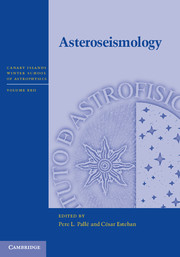Book contents
- Frontmatter
- Contents
- List of contributors
- List of participants
- Preface
- Acknowledgments
- Abbreviations
- 1 Sounding the solar cycle with helioseismology: Implications for asteroseismology
- 2 Learning physics from the stars: It's all in the coefficients
- 3 Solar-like oscillations: An observational perspective
- 4 Studying stars through frequency inversions
- 5 A crash course on data analysis in asteroseismology
- 6 An observer's views and tools
- 7 Asteroseismology of red giants
- References
6 - An observer's views and tools
Published online by Cambridge University Press: 05 December 2013
- Frontmatter
- Contents
- List of contributors
- List of participants
- Preface
- Acknowledgments
- Abbreviations
- 1 Sounding the solar cycle with helioseismology: Implications for asteroseismology
- 2 Learning physics from the stars: It's all in the coefficients
- 3 Solar-like oscillations: An observational perspective
- 4 Studying stars through frequency inversions
- 5 A crash course on data analysis in asteroseismology
- 6 An observer's views and tools
- 7 Asteroseismology of red giants
- References
Summary
Introduction
The four lectures that I presented at the XXII Winter School of Astrophysics were an eclectic mix of topics loosely bound under the title of this chapter: an observer's views and tools. The presentations given by all of the lecturers at the Winter School are available at the time of this writing on the IAC Web site (see “about the school” and “lecturers and topics” on that web site). This chapter can be read in conjunction with the lecture presentations on that web site, but that is not required. This chapter does not completely follow the order of the presentations.
Chemically peculiar and pulsating stars of the upper main sequence
On and near the main sequence for Teff > 6, 600 K, there is a plethora of spectrally peculiar stars and photometric variable stars with a bewildering confusion of names. There are Ap, Bp, CP, and Am stars; there are classical Am stars, marginal Am stars, and hot Am stars; there are roAp stars and noAp stars; there are magnetic peculiar stars and nonmagnetic peculiar stars; He-strong stars, He-weak stars; Si stars, SrTi stars, SrEuCr stars, HgMn stars, PGa stars; λ Boo stars; stars with strong metals, stars with weak metals; pulsating peculiar stars, nonpulsating peculiar stars; pulsating normal stars; nonpulsating normal stars; δ Sct stars, δ Del stars, and ρ Pup stars; γ Dor stars, SPB stars, β Cep stars; γ Cas stars, λ Eri stars, α Cyg stars; sharp-lined and broad-lined stars, some of which are peculiar and some of which are not.
- Type
- Chapter
- Information
- Asteroseismology , pp. 163 - 193Publisher: Cambridge University PressPrint publication year: 2014

